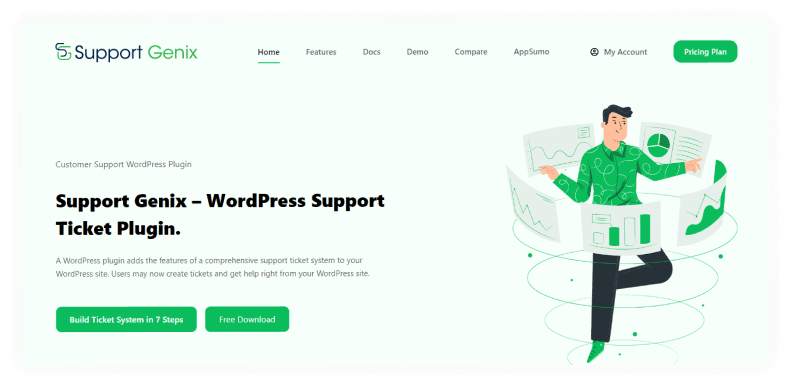How to Train Your Customer Support Team to Provide Exceptional Service: The Ultimate Guide
Are you looking for effective strategies on how to train your customer support team to provide exceptional service? The customer service experience can make or break your business, so it’s important to invest in well-trained customer support.
By utilizing the right training techniques and tools, you can ensure that your customer support team is equipped with the skills needed to deliver outstanding service.
In this blog post, we’ll share some useful tips on how to train your customer support team so they can provide superior service every time.
Understanding Customer Service
Providing excellent customer service is crucial to the success of any business. Studies show that customers are more likely to repeat business with companies that provide outstanding customer support.
To train your customer support team to deliver exceptional service, it’s important to first understand the core principles of customer service. This includes understanding the needs, wants, and expectations of your customers.
One way to gain insight into your customers is to conduct surveys or gather feedback from them. This will help you identify common pain points and areas for improvement. You can then use this information to develop training programs tailored to address these concerns.
Another crucial aspect of exceptional customer service is effective communication. Your customer support team should be trained to actively listen to the customer, empathize with their situation, and communicate clearly and professionally. This can be achieved through role-playing exercises, practical communication training, and ongoing coaching and feedback.
Additionally, efficient problem-solving skills are essential to delivering outstanding customer service. Your team should be equipped with the tools and knowledge needed to address customer concerns quickly and effectively. This includes having access to a comprehensive knowledge base, as well as guidelines for handling specific types of customer inquiries.
Finally, it’s important to foster a positive and enthusiastic culture within your customer support team. Employees who are happy and motivated will be more likely to provide exceptional customer service. This can be achieved through team-building exercises, recognition and rewards programs, and ongoing training and development opportunities.
By investing in training programs for your customer support team, you can ensure that your customers receive exceptional service every time they interact with your business. This will not only boost customer satisfaction and loyalty but can also lead to increased sales and revenue over time.
Assessing Your Customer Support Team
Once you have a clear understanding of the principles of excellent customer service, it’s time to assess your customer support team. Determine what skills and knowledge they need to deliver superior service. This will help you create an effective training program that meets their needs.

Identifying the strengths and weaknesses of your team
Identifying the strengths and weaknesses of your customer support team is a critical aspect of training. It’s essential to understand where your team excels and where they need improvement. By identifying these areas, you can tailor your training programs to address any gaps in their skills or knowledge.
One effective way to identify strengths and weaknesses is to conduct regular performance evaluations. During these evaluations, you can assess your team’s communication skills, problem-solving abilities, and overall productivity. You can also use metrics such as response time and customer satisfaction ratings to measure their performance.
Another key factor in assessing your team is understanding their individual strengths and weaknesses. Some team members may excel in certain areas, such as handling difficult customers, while others may struggle with specific tasks, such as technical support. By understanding each team member’s strengths and weaknesses, you can assign tasks accordingly and provide targeted training to improve their skills.
Conducting a customer service audit
Conducting a customer service audit is an essential step in ensuring that your business is delivering outstanding customer support. By assessing the strengths and weaknesses of your customer support team, you can identify areas for improvement and tailor your training programs to address any gaps in their skills or knowledge.
When conducting a customer service audit, it’s important to gather as much data as possible. This can include metrics such as response time, customer satisfaction ratings, and the number of complaints or inquiries received. You can also conduct surveys or gather feedback from customers to gain insight into their experiences with your customer support team.
Setting performance goals
Once you’ve identified the strengths and weaknesses of your customer support team, it’s time to set performance goals. These goals should be specific, measurable, and achievable. They should also be realistic so that your team can achieve them without becoming overwhelmed or discouraged.
For example, one goal could be reducing response times by 25 percent in the next three months. Another goal could be increasing customer satisfaction ratings by 10 percent in the next six months. It’s important to set goals for both individual team members and the entire team so that everyone is working toward common objectives.
Support Genix
WordPress Support Ticket Plugin
Take Your Customer Support to The Next Level and Boost Customer Satisfaction Rates
Training Strategies
Once you have identified the strengths and weaknesses of your customer support team, established performance goals, and conducted a customer service audit, it’s time to create an effective training program. There are several strategies you can use to ensure that your customer support team is properly trained and equipped to deliver outstanding service.
Creating a customer service training program
To ensure that your customer support team is delivering exceptional service, it’s important to create a comprehensive training program. This program should consist of both theoretical and practical components so that team members can gain both the knowledge and skills necessary to deliver excellent customer service.
When creating a training program, consider including activities such as role-playing scenarios, mock customer calls, and problem-solving exercises. These activities will help team members gain hands-on experience and understand the expectations of customers.
It’s also important to provide ongoing feedback and support throughout the training process. This will ensure that your team members are on track with their goals and can quickly address any issues or concerns they may have.
Incorporating role-playing exercises and simulations
Role-playing exercises and simulations can be an effective way to prepare your team for customer interactions. These activities will help them become more confident, understand customer expectations, and practice problem-solving skills in a safe environment.
For example, role-playing scenarios can simulate real customer service interactions. You can provide team members with specific situations, such as a customer who is unsatisfied with the product they received or a customer who is requesting a refund. Team members can then practice responding to the customer in different ways and get feedback on their performance.
Simulations, on the other hand, can help team members learn how to navigate more complex situations. For example, using an online platform, you can provide team members with a simulated customer service experience. They can then practice responding to customer inquiries in the virtual environment and receive feedback on their performance.
These activities will help your team become more confident when speaking with customers and better prepared for any difficult situations that may arise.
Tools for Effective Customer Support
In addition to training, it’s important to equip your team with the right tools to deliver effective customer support. There are many software and systems available that can help streamline customer service interactions and improve efficiency.
For example, customer relationship management (CRM) software can be used to store detailed customer information. This allows team members to quickly access customer data, such as past orders and contact information, and provide more personalized service.
Live chat software can also be used to provide instant support. This allows customers to get their questions answered in real time without having to wait on hold or send an email.
Finally, automated systems can be used to streamline routine tasks and improve efficiency. This can include automated email response systems, self-service knowledge bases, and AI-based chatbots.
By equipping your team with the right tools, you can ensure that customer service interactions are handled quickly and efficiently.
Using a Reliable Customer Support Software
If you are looking for reliable customer support software to manage your support ticket from your Website in one place, the Support Ticket WordPress plugin is worth checking out.

Support Genix is a powerful WordPress plugin designed to help businesses provide effective customer support. It offers modern features like Ticket Transfer, Agent Control, WooCommerce Integration, Email Piping, IMAP Setting, Auto Ticket Setup, and integration with other applications like Envato, Elite Licenser, etc., and many more.
How to Choose the Best WordPress Support Ticket Plugin for Your Business
The Top 10 Customer Service Software Solutions in 2023
Offering access to knowledge base and learning resources
Providing access to a knowledge base and learning resources can be an effective way to improve customer service. A comprehensive knowledge base should include asked questions, how-to guides, and other relevant information that customers may need when seeking help.
Using analytics and feedback to improve customer support
Analytics and feedback are essential for improving customer service. By tracking customer interactions, you can identify patterns and trends in customer complaints, allowing you to more quickly address them. You can also use the data to continuously improve your customer support processes and train your team accordingly.

Best Practices of How to Train Your Customer Support Team
Empowering your team to make decisions
It’s important to empower your team members to make decisions in order to provide effective customer service. This means giving them the freedom to address customer issues and concerns as they see fit, within reasonable boundaries. This will help ensure that customers are receiving the best possible service and that their issues are being addressed quickly and effectively.
Encouraging active listening and empathizing with customers
Active listening is an important skill for customer service professionals. By actively listening to customers, team members can better understand their needs and empathize with them. This will help create a more positive customer experience, leading to improved customer satisfaction.
Following up with customers
Following up with customers after they have received assistance is another effective way to improve customer service. This allows customers to provide feedback and ensures that they are satisfied with their experience. It also gives you the opportunity to address any issues or concerns they may have had, which can help prevent future problems.
Responding promptly to customer inquiries
Responding promptly to customer inquiries is essential for providing good customer service. Customers expect their questions and concerns to be addressed in a timely manner, so it’s important to make sure that your team is responding quickly and efficiently. This will help ensure that customers feel valued and appreciated, creating a positive experience for them.
Providing personalized service to build rapport with customers
Personalized service is a great way to build rapport with customers. By going the extra mile and taking the time to get to know customers, you can create stronger relationships and make them feel more valued. This will help improve customer loyalty and satisfaction, ultimately leading to better customer service.
Handling difficult customers with tact and professionalism
Dealing with difficult customers is an unavoidable part of customer service. It’s important to handle these situations with tact and professionalism, as it can help de-escalate the situation and ensure that customers feel heard and respected. This will ultimately lead to better customer satisfaction and a more positive experience for all involved.
Support Genix
WordPress Support Ticket Plugin
Take Your Customer Support to The Next Level and Boost Customer Satisfaction Rates
Frequently Asked Questions on How to Train Your Customer Support Team
Q: Why is customer service training necessary?
A: Customer service training is necessary for several reasons. Firstly, it ensures that your team members have the skills and knowledge necessary to handle customer inquiries and complaints effectively. Secondly, it helps create a culture of customer service within your organization, emphasizing the importance of providing exceptional service to your customers. Lastly, it can lead to increased customer satisfaction, which can have a positive impact on your business’s reputation and bottom line.
Q: What are some key components of effective customer service training?
A: Effective customer service training should cover a range of topics, including communication skills, problem-solving techniques, product knowledge, and conflict resolution strategies. It should also include hands-on experience and opportunities for role-playing and feedback. Additionally, ongoing training and development should be provided to ensure that team members stay up-to-date with the latest trends and best practices.
Q: How can you measure the effectiveness of customer service training?
A: There are several ways to measure the effectiveness of customer service training. One way is to track customer satisfaction ratings and compare them before and after the training. Another way is to conduct surveys or focus groups with team members to get their feedback on the training and identify areas for improvement. Lastly, you can monitor key performance indicators such as call resolution time, customer wait time, and first-call resolution rate, to see if there has been any improvement since the training.
Q: What are some common challenges that customer service teams face, and how can they be overcome?
A: Common challenges that customer service teams face include dealing with difficult customers, handling high call volumes, and staying up-to-date with product and service knowledge. These challenges can be overcome through effective training, ongoing coaching and feedback, and the implementation of tools and technology that streamline processes and enhance customer self-service options. Additionally, encouraging a positive team culture and providing recognition and incentives can help keep team members motivated and engaged.

Conclusion
Customer service training is essential for any business that wants to provide exceptional customer service. By teaching team members the skills and knowledge necessary to handle customer inquiries and complaints effectively, you can create a culture of customer service focused on providing positive experiences for customers.
Additionally, ongoing training and development as well as feedback and recognition are important components of an effective customer service training program. By addressing common challenges and providing the necessary tools and resources, businesses can ensure that their customer service teams are well-equipped to provide a high level of satisfaction for their customers.
In conclusion, customer service training is essential for any business that wants to provide exceptional customer service.


